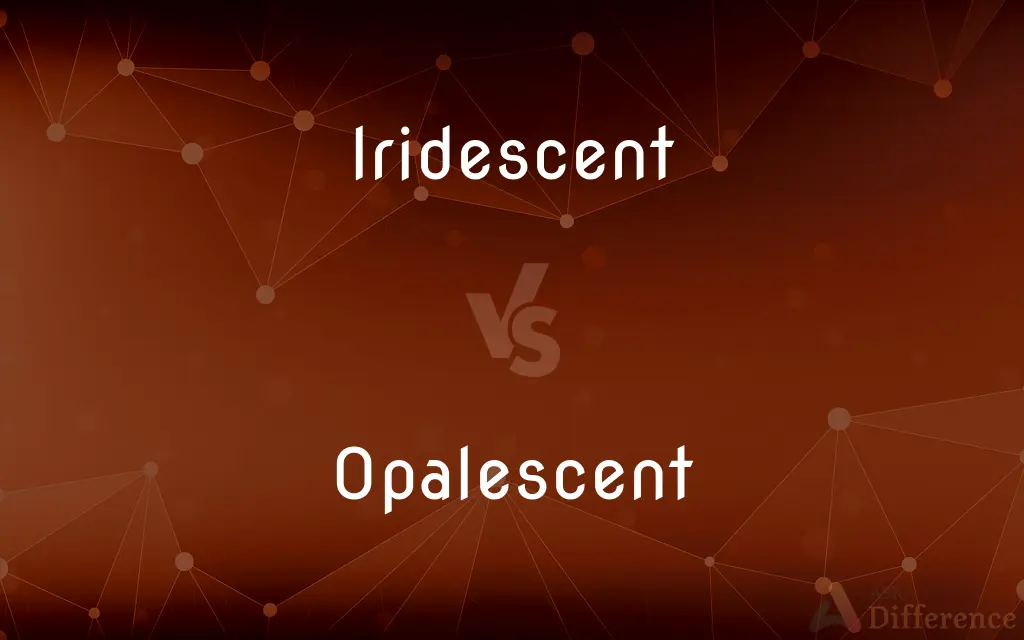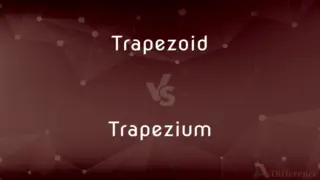Iridescent vs. Opalescent — What's the Difference?
By Urooj Arif & Fiza Rafique — Updated on March 25, 2024
Iridescence produces rainbow-like colors that change with viewing angle, resulting from the diffraction of light, while opalescence is form of iridescence with milky, pearly appearance, often with a play of colors against white or light background.

Difference Between Iridescent and Opalescent
Table of Contents
ADVERTISEMENT
Key Differences
Iridescence is a phenomenon where an object's surface appears to gradually change color as the angle of view or the angle of illumination changes. This effect is due to the microscopic structure of the surface, which causes the diffraction and interference of light waves. In contrast, opalescence refers to a specific type of iridescence characterized by a pearly luster or glow, often with a translucent quality. Opalescence typically displays a play of colors against a lighter background, giving it a milky or cloudy appearance.
The creation of iridescence is often seen in nature, such as in the wings of certain butterflies and the feathers of some birds, as well as in various man-made materials. Opalescence, on the other hand, is particularly noted in gemstones like opals, where it gives a distinctive shimmering quality that has been highly valued in jewelry. While iridescence is caused by the structural composition of a surface that diffracts light, opalescence in gemstones results from the diffraction of light caused by microscopic silica spheres within the stone.
Both phenomena contribute to the beauty and visual interest of objects and materials. Iridescence can be observed in a wide range of colors depending on the structure of the surface and the light conditions. Whereas opalescence is usually associated with a warm, inviting glow, often seen in light passing through opal or similar materials, creating a unique aesthetic appeal.
Despite these differences, the underlying principles of light interaction—diffraction and interference—are central to both iridescence and opalescence. However, opalescence is considered a subset of iridescence with specific characteristics, such as its milky transparency and the predominance of warm tones, which set it apart from the broader category of iridescent effects.
Comparison Chart
Definition
Color changes with viewing angle due to light diffraction and interference.
A type of iridescence with a milky, pearly appearance, often with warm tones.
ADVERTISEMENT
Cause
Structural surface variations that diffract light.
Microscopic silica spheres in materials like opals that diffract light.
Appearance
Can produce a wide spectrum of colors.
Typically displays warm colors against a light, often milky background.
Common Examples
Butterfly wings, soap bubbles, oil on water.
Opals, certain glass types, and pearls.
Associated Quality
Bright, vivid color shifts.
Soft, pearly glow with a translucent quality.
Compare with Definitions
Iridescent
Results from light diffraction and interference.
Soap bubbles display iridescence due to thin film interference.
Opalescent
Caused by microscopic structures within the material.
The opalescence in pearls is due to the layering of nacre.
Iridescent
Phenomenon where surfaces appear to change color with the angle of view/light.
The iridescence of a peacock feather fascinated her with its vivid colors.
Opalescent
Often associated with gemstones like opals.
The opal's opalescence made it look like it contained a universe of colors.
Iridescent
Produces a rainbow of colors.
The beetle's shell gleamed with iridescent blues and greens under the sunlight.
Opalescent
Visible in translucent materials.
The vase's opalescent finish diffused the light beautifully, casting warm hues.
Iridescent
Observed in nature and synthetic materials.
Iridescent paint is used in art to mimic nature's dynamic color shifts.
Opalescent
Characterized by a play of warm colors.
Opalescent glassware is prized for its soft glow and depth of color.
Iridescent
Depends on the structural composition.
The iridescent effect on a CD is due to the grooves diffracting light.
Opalescent
Type of iridescence with a milky, pearly glow.
The opalescence of the moonstone necklace gave it a mystical appeal.
Iridescent
Producing a display of lustrous, rainbowlike colors
An iridescent oil slick.
Iridescent plumage.
Opalescent
Showing many small points of shifting colour against a pale or dark ground
An opalescent sky
Iridescent
Brilliant, lustrous, or colorful in effect or appearance
"The prelude was as iridescent as a prism in a morning room" (Carson McCullers).
Opalescent
Exhibiting a milky iridescence like that of an opal.
Iridescent
(not comparable) Producing a display of lustrous, rainbow-like colors; prismatic.
Opalescent
Exhibiting a milky iridescence like that of an opal.
Iridescent
Brilliant, lustrous, or colorful.
Opalescent
Reflecting a milky or pearly light from the interior; having an opaline play of colors.
Iridescent
Having colors like the rainbow; exhibiting a play of changeable colors; nacreous; prismatic; as, iridescent glass. See iridescence.
Opalescent
Having a play of lustrous rainbow-like colors;
An iridescent oil slick
Nacreous (or pearlescent) clouds looking like mother-of-pearl
A milky opalescent (or opaline) luster
Iridescent
Varying in color when seen in different lights or from different angles;
Changeable taffeta
Chatoyant (or shot) silk
A dragonfly hovered, vibrating and iridescent
Iridescent
Having a play of lustrous rainbow-like colors;
An iridescent oil slick
Nacreous (or pearlescent) clouds looking like mother-of-pearl
A milky opalescent (or opaline) luster
Common Curiosities
Why do some objects display iridescence only from certain angles?
The angle-dependent color change in iridescence results from the way light waves diffract and interfere due to the object's microscopic surface structure.
What is opalescence, and how does it differ from iridescence?
Opalescence is a specific type of iridescence with a milky, pearly glow, often displaying warm colors against a light background, differing from the broader, more color-variable phenomenon of iridescence.
Are iridescence and opalescence only visual phenomena?
Primarily, yes. They are optical effects related to the way light interacts with the microscopic structure of materials, though they can influence material properties like visibility and perceived texture.
Can opalescence be found in materials other than opals?
Yes, opalescence can also be observed in certain types of glass, pearls, and other translucent materials.
Is iridescence always caused by surface structure?
While often due to surface structures, iridescence can also result from internal structures or layers within a material.
How is iridescence used in design and art?
Iridescence is used in fashion, jewelry, paintings, and architectural elements to add dynamic visual interest and mimic natural beauty.
What causes iridescence?
Iridescence is caused by the structural composition of a surface, leading to the diffraction and interference of light.
Why are iridescence and opalescence valued in jewelry?
These effects add a unique, dynamic quality to gemstones and materials, enhancing their beauty and perceived value.
Can the opalescent effect be artificially created?
Yes, opalescent effects can be created in glass and other materials through the controlled inclusion of substances that diffract light similarly to natural opals.
What role does the structure play in iridescence and opalescence?
The microscopic or nanostructure of the material is crucial in both phenomena, determining the specific patterns and colors of light that are diffracted.
Share Your Discovery

Previous Comparison
Trapezoid vs. Trapezium
Next Comparison
Grammar vs. LiteratureAuthor Spotlight
Written by
Urooj ArifUrooj is a skilled content writer at Ask Difference, known for her exceptional ability to simplify complex topics into engaging and informative content. With a passion for research and a flair for clear, concise writing, she consistently delivers articles that resonate with our diverse audience.
Co-written by
Fiza RafiqueFiza Rafique is a skilled content writer at AskDifference.com, where she meticulously refines and enhances written pieces. Drawing from her vast editorial expertise, Fiza ensures clarity, accuracy, and precision in every article. Passionate about language, she continually seeks to elevate the quality of content for readers worldwide.














































